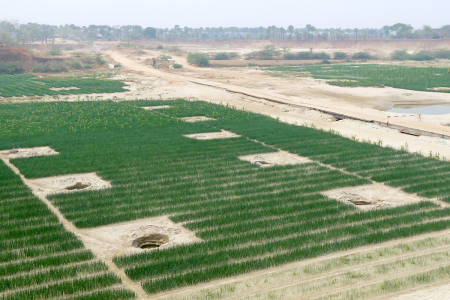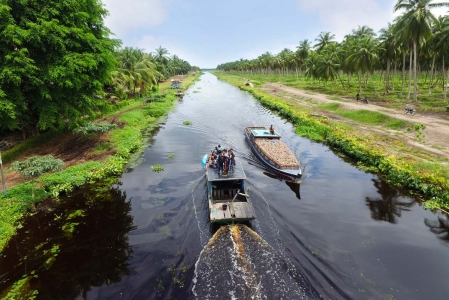A WLE Op-Ed also published in thethirdpole.
First detailed climate assessment for Western Nepal predicts water risks on supplies, farmers and communities will be more severe than expected.
It’s been said that climate change is water change. And this is proving to be starkly true for Nepal. As the world marks World Water Day this week, the first study to use state-of-the-art modeling to forecast climate change impacts across the Himalayan region is predicting changes even more severe than previously expected.
Western Nepal is likely to see warmer temperatures, a prolonged monsoon, and sporadic and intense rain events across all regions. And some areas are set to experience more extreme events, such as floods and droughts. These changes could have severe impacts on water supplies, and on the farmers and communities that rely on them.
The Himalayas, which extend across Nepal, have been recognized as a hotspot for climate change impacts, as the phenomenon affects higher elevations faster than lower ones. Within Nepal, the Western region has been identified as particularly vulnerable to climate change because of both its biophysical features and the low capacity of its people to adapt. However, there are still very few climate studies aimed at helping Himalayan countries plan for the future. The new research indicates that the highest temperature changes will take place in the mountains, while the greatest fluctuations in precipitation will affect the lower hills and Terai plains. Such information is invaluable for those planning future water use.
Getting the full picture
Although extending only 200km from north to south, Nepal’s landscape stretches from the highest mountains in the world (at over 8000m) to lowland plains (at around 100m), and hosts many unique geological pockets with their own micro-climates and ecosystems. This means that traditional global climate models, which forecast change at scales of thousands of kilometers, cannot accurately predict future climate shifts. To help overcome this, the Coordinated Regional Downscaling Experiment for South Asia (CORDEX-SA) is building Regional Climate Models (RCMs) that represent South Asia at a finer scale.
Among the first to put these models to the test, scientists from the International Water Management Institute (IWMI) examined predictions from 19 of the CORDEX-SA RCMs at near-, mid-, and far-future scenarios. They then compared the results with trends observed in climate data gathered over the past half-century by the Nepalese government. And finally, where gaps existed in the data collected by the first two methods, the team interviewed people to gather their perceptions on how the climate had changed over their lifetimes.
The climate assessment revealed that Western Nepal can expect even greater change and more variability than reported by global climate models for the wider Hindu-Kush Himalayas. And, perhaps most importantly, it indicated that the change would vary even within the region’s different geographical areas. For example, the monsoon was forecast to become wetter in the mountains but drier on the hills and plains, with more extreme climate events affecting both. This suggests that water scarcity could become a pressing issue in the Terai, while melting glaciers from rising temperatures would be the main climate challenge in the mountains. Results from other studies have shown that glacier area already decreased by 25% throughout Nepal, just between 1980 and 2010.
One reason why Western Nepal is particularly vulnerable to climate change is its heavy reliance on rainfed farming. Changes to when the monsoon starts and ends, increased temperatures and changing patterns of where and how rain falls all have the potential to disrupt farming cycles. If a particular volume of water falls as rain over a couple of days the soil can absorb it, so crops can make use of it. But if the same amount falls in half a day, it can cause flooding and soil erosion. Changes in weather patterns therefore have a high impact on rainfed farming.
Applying the findingsWe are now examining how the forecast changes revealed by the climate assessment will affect water availability in Western Nepal, and the impacts this may have on specific sectors, including agriculture, tourism and energy. There are plans in the pipeline for large irrigation, hydropower and inter-basin water transfer programmes in Western Nepal, which could potentially be affected. Moreover, with the region’s Karnali river basin forming the headwaters of the Ganges, there are implications for water availability beyond Nepal’s borders, in India and Bangladesh.
Our scientists are working with Nepal’s government to help it develop robust policies and implementation plans in response to the climate assessment. A two-way relationship, the policymakers are also feeding back information to IWMI on our research, to help us frame appropriate follow-up projects. Generating climate futures at sub-national levels enables tailored assessments and subsequent mitigation plans to be put in place before the projections become a devastating reality.
The study marks the first step towards using these state-of-the-art regional climate models to generate detailed climate projections for Western Nepal. Our team is also researching future water scenarios in other highly vulnerable developing countries, such as Myanmar, which are often overlooked in the global climate context. With more accurate predictions, we will be better placed to tackle these water challenges together.
Luna Bharati is Principle Researcher in Hydrology and Water Resources, and Dani Freund is Princeton in Asia Fellow, at IWMI. Their work is supported by the CGIAR Research Program on Water, Land and Ecosystems (WLE) and international development agency USAID.
Read more about the research project on which this article is based in Climate futures for Western Nepal based on regional climate models in the CORDEX-SA
For more information on IWMI/WLE’s recent research into climate change in Nepal and the wider Himalayas, see:
• Agriculture under changing climate conditions and adaptation options in the Koshi Basin
• Climate Shocks and Responses in Karnali-Mahakali Basins, Western Nepal
---
Thrive blog is a space for independent thought and aims to stimulate discussion among sustainable agriculture researchers and the public. Blogs are facilitated by the CGIAR Research Program on Water, Land and Ecosystems (WLE) but reflect the opinions and information of the authors only and not necessarily those of WLE and its donors or partners.
WLE and partners are supported by CGIAR Trust Fund Contributors, including: ACIAR, DFID, DGIS, SDC, and others.









%208508917731_1d20b6e823_k/index.jpg?itok=NREhK_UC&c=072d3078fd8af3847b286bc356566a57)







